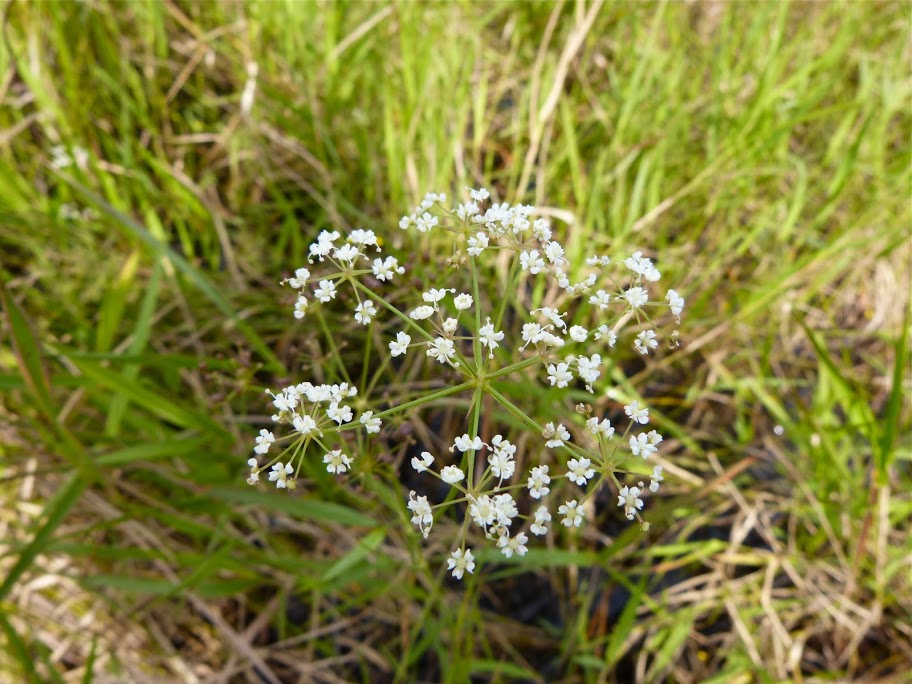Map Snapshot


3 Records
Status
Canby's Cowbane is a globally rare native plant that in Maryland is restricted to only one population on the Eastern Shore where the species reaches its northern limits. According to NatureServe, "Oxypolis canbyi is native to the Coastal Plain from southwestern Georgia through South Carolina to southeastern North Carolina, and from eastern MD to (historically) Delaware. Approximately 40 occurrences are believed extant, mostly in South Carolina and Georgia, with an additional 16 occurrences considered historical or of unknown status. There are likely over 10,000 total plants, as at least three Georgia occurrences have "thousands" of plants, and at least four South Carolina occurrences are described as "very large." Other sites have fewer plants. This species' herbaceous wetland habitats - characterized by long periods of inundation and little canopy cover - have declined significantly from historical levels due to drainage and conversion to pasture, farmland, and pine plantations. This threat continues to some extent presently. Habitat degradation is the other major threat to this species, primarily resulting from hydrological alterations and/or fire suppression, both of which can alter successional patterns to the detriment of this species. Water table-lowering activities in the general vicinity of sites can still constitute significant hydrological alteration, such that protecting the sites themselves may be insufficient to ensure persistence. A significant proportion of known occurrences are described as declining in habitat quality and/or population size; many require active management." MD DNR says that Maryland's one location for this globally imperiled plant is found in a Delmarva Bay. Heavy management by various agencies including the Nature Conservancy and MD DNR have brought Maryland's Canby's Cowbane population back from the brink of extirpation. According to NatureServe, "Between 1986 and 1988 [Maryland's population] declined from 100-200 to 7 plants...The Maryland occurrence appeared to be fluctuating but not necessarily declining in 1993-2001 monitoring, following reintroduction of plants (from the population) propagated ex situ. NatureServe goes on to say that the, "Maryland populations are now fluctuating between 14 and 82 plants over nine years of detailed monitoring."
Seasonality Snapshot
Source: Wikipedia
| Tiedemannia canbyi | |
|---|---|

| |
| Scientific classification | |
| Kingdom: | Plantae |
| Clade: | Tracheophytes |
| Clade: | Angiosperms |
| Clade: | Eudicots |
| Clade: | Asterids |
| Order: | Apiales |
| Family: | Apiaceae |
| Genus: | Tiedemannia |
| Species: | T. canbyi
|
| Binomial name | |
| Tiedemannia canbyi (J.M.Coult. & Rose) Feist & S.R.Downie (2012)
| |
| Synonyms[1] | |
| |
Tiedemannia canbyi (syn. Oxypolis canbyi) is a rare species of flowering plant in the carrot family known as Canby's dropwort and Canby's cowbane.[2][3][4] It is native to the southeastern United States, where it occurs on the Atlantic coastal plain from North Carolina to Georgia, as well as the Chesapeake Bay area. It is threatened by the loss of the wetland habitat in which it grows.[5] It is a federally listed endangered species of the United States.
Description
[edit]This rhizomatous perennial herb grows up to 1.2 meters in maximum height. The narrow, hollow leaves resemble quills. The inflorescence is a compound umbel of many small flowers with white petals and red-tinged green sepals.[6] Blooming occurs in August and September,[7] sometimes lasting until October.[6] The plant has a scent similar to dill. The stems extend along the ground as stolons, rooting at nodes. It can then produce a colony of many erect stems all belonging to one plant, spreading vegetatively.[6]
Ecology
[edit]The larva of the black swallowtail butterfly (Papilio polyxenes asterius) feed on the plant.[6] They eat the stem, separating the inflorescence and sometimes preventing sexual reproduction; however, the plant more often reproduces asexually via cloning.[7]
Conservation status
[edit]There are about 53 documented populations of this plant, mainly in South Carolina and Georgia. There is one population each in Maryland and North Carolina. The species has been extirpated from Delaware. Most populations are small. The plant grows in a variety of wetland habitat types, including bays, sloughs, wet savannas, and ponds.[6] Other plants in the habitat may include Ilex myrtifolia, Nyssa biflora, Taxodium ascendens, Pinus serotina, Stillingia aquatica, Rhynchospora tracyi, Rhynchospora inundata, Manisuris rugosa, Rhexia aristosa, Polygala cymosa, Pluchea rosea, Lobelia boykinii, and Hypericum denticulatum.[5]
The main threat to this rare species is the destruction and alteration of its habitat.[6] Wetlands across the coastal plain of the southeastern US have been dredged, drained, and used for agriculture, including silviculture operations. This process has altered the water regime, both on the surface and in the groundwater table, which in turn has affected the flora. In some cases, shrubs have invaded areas where they were naturally excluded in the pristine habitat. The dropwort grows best in open, unshaded areas that have no canopy. Conservation activities have included the removal of shrubs and trees, including sweetgum (Liquidambar styraciflua) and persimmon (Diospyros virginiana), that had been encroaching on the wetland and shading out the herb layer.[6]
References
[edit]- ^ "Tiedemannia canbyi (J.M.Coult. & Rose) Feist & S.R.Downie", Plants of the World Online, Royal Botanic Gardens, Kew, retrieved 26 December 2022
- ^ "Tiedemannia DC". Plants of the World Online. Royal Botanic Gardens, Kew. Retrieved 21 August 2020.
- ^ Weakley, Alan S. (2018), Flora of the Southern and Mid-Atlantic States, working draft of 20 August 2018, University of North Carolina Herbarium, North Carolina Botanical Garden, University of North Carolina at Chapel Hill
- ^ "Tiedemannia - Genus Page - ISB: Atlas of Florida Plants". florida.plantatlas.usf.edu. Retrieved 21 August 2020.
- ^ a b Oxypolis canbyi. The Nature Conservancy.
- ^ a b c d e f g USFWS. Oxypolis canbyi Five-year Review. September 2010.
- ^ a b Oxypolis canbyi. Center for Plant Conservation.


